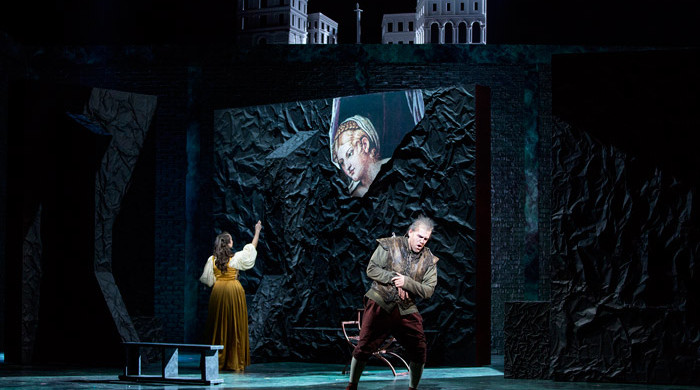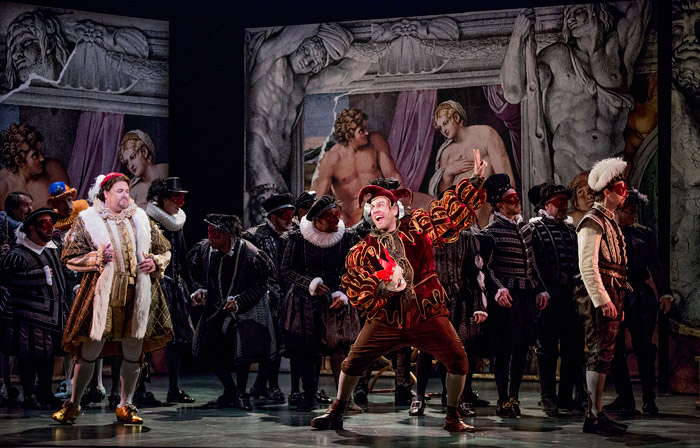I happened to be at the premiere of the new production of Rigoletto by Boston Lyric Opera. Unlike any other Rigoletto I’ve seen, this particular production hits you right in the gut. To find out why, I went behind the scenes to interview the director, costume designer, set designer, and main character. I wanted to see how through their personal stories, as well as their collaborative work, the ultimate vision of Rigoletto was created.
Vita Tzykun, costume designer:
Masha Froliak: What time period did you work with on this production?
Vita Tzykun: The approach we chose was that of Mannerism—when the Renaissance went out of control. If during the Renaissance all the shapes were absolutely symmetrical, during this period they became much more distorted: figures became elongated, dresses became larger, shoulders became wider. The society of Rigoletto is one during which the Duke has absolute power of his court. We wanted to present it in this exaggerated mannerist period.
MF: There must have been a lot of historical research?
VT: It was like learning a new language, really. They had many pieces of clothing that we don’t currently have today; they all had different names, they were made differently, and connected together differently. The colors, shapes, and layers had their own meanings. The larger your silhouette was, and the more fabric you had in your clothing—the wealthier you were. That is why you could see the duke wearing really voluptuous pants, a broad shoulder doublet, and a large fur-lined cape.
MF: Apart from being accurate to the historical time, this production had a variety of stylistic decisions. Can you tell about some of them?
VT: The production is quite stylized in the sense that after Rigoletto is cursed, we see the events through his mind. When Gilda is violated by the Duke, Rigoletto starts seeing her in all-white like an innocent flower. It was important for me to create this pure white and the somewhat non-specific, abstract silhouette. In the end she becomes a ghost; so the symbol of white changes from innocence to ghostly innocence–an impossible ideal. Also, it was a costume decision to make Rigoletto progressively crippled. After the curse, his deformity becomes steadily worse–his hump grows bigger and his leg has a support that grows taller, making it more difficult for him to walk.
Michael Mayes, Rigoletto:
MF: Did the costume influence the evolution of your character?
Michael Mayes: Rigoletto is one of the crown jewels of baritone repertoire; it is a pinnacle, and it is where you want to get your whole life. It is also a very difficult role emotionally, technically, and physically. In the beginning, I was at a loss at how to play this character. Then I got one of Vita’s sketches of a thin, frail man. He was bent over, dragging his jester’s outfit and holding a hat. Her sketch really defined for me what my character was going to be. It inspired my entire vision of Rigoletto.
MF: How did you prepare yourself emotionally for this role?
MM: It sounds very simple–I read the story. I don’t know what it is like to be the father, but I do know what it is like to lose everything you care about in your life. It has happened to me and so I tap into those emotions when I am on stage, I tap into what it feels like to watch your entire world being taken away from you. That is what happens to Rigoletto. No matter what he does, it is one further step towards desolation.
MF: You probably have heroes or role models among baritones who sang Rigoletto–how did that influence your performance? Did it help or distract you?
MM: My heroes in this role are Cornell Macneil, Sherill Milnes, and Leonard Warren, among others. The Met has great on-demand recordings, and I have been listening to them my whole life. But, at some point you have stop listening to those guys. You have to find your own voice. We are living in a time haunted by the ghosts of the greatest baritones that had ever lived. Now when a great baritone dies there are four or five versions of his Rigoletto that you are always fighting. Sometimes you simply have to turn it off.
MF: I assume it is very difficult for an opera singer to sing and act simultaneously. In your performance you were bent over most of the time. How did you manage?
MM: This is the most difficult thing I have done on stage. It is incredibly technically difficult. Plus, the emotions in this piece are really powerful. But I am always an actor first. I am an actor who sings, not a singer who acts. My acting and emotional state in every moment is the source from which everything else comes. To be bent over all the time makes it hard to access your support, because you are really cut in half, it is a constant battle to be present in the moment, to react to everything that happens on stage, but also to be aware of the fact that I have to breathe and sing.
John Conklin, set designer:
MF: Can you explain the interplay of outside and inside in your sets—a marble model of the city, which represents an illusion of something ideal on the one hand, and at the same time dark brick walls on the inside?
John Conklin: The opera itself is divided in two: the more opulent, rich, and decadent world of the court, juxtaposed against the dark side of Rigoletto’s mind. The scenery is literally two-sided; on one side there are court paintings, and on the other just dark material. I felt that there was also a division between an ideal world and a world of passion, revenge, murder, and dark impulse. The brick walls are the container of violent action, and then above them there is a white marble city, which looks down ironically on the actions below.
MF: What is the symbolism of the imagery and your choice of paintings?
JC: I wanted to find a painting which provides contrast against the pure Renaissance of the city above (the Renaissance of Piero della Francesca). The paintings were based on Annibale Carracci, who is more connected with mannerism. We see Venus, Mars, and Cupid presented in an erotic way. There is also a naked figure of a boy from Michelangelo’s fresco in the ceiling of the Sistine Chapel. There are gigantic nude male figures, and also a naked woman in the midst. There is an erotic side, but also the question of the meaning of love. In the opera we see paternal love and we also see the sexual attraction shared between the Duke and Gilda. I think that the combined images of love and sexuality are part of the ambiguity of the whole piece.
MF: What would you say was your main idea or aim in this piece?
JC: Rigoletto is a very powerful piece and it is very strongly written in its musical and narrative structure. The idea was to tell two stories—to tell the narrative, the plot, but also to get beneath the surface of the story.
Tomer Zvulun, Director:
MF: What was the most difficult part for you in this production?
Tomer Zvulun: I had a very clear idea of what I wanted to do with it. But, the most beautiful and the most challenging thing about opera itself is the work’s collaborative nature. As the director, you have to take your idea and share it, enhance it with a few hundred people: your designers, conductor, singers, prop people, makeup artists, etc. Opera is a very collaborative art form and if your vision is clear people will join it.
MF: The deconstruction-deformation process seemed to be a crucial element in your vision of Rigoletto. Could you elaborate on this?
TZ: We really wanted to get into his mind. Costumes, sets, lighting, and of course staging were geared towards that goal. From the moment he is cursed, the lighting changes and the scrim separates him from the rest of the world. He starts to see things through the scrim—things that are threatening to him, such as the Duke, and also things that are precious to him, such as his daughter. As the show progresses, the different things he sees in his mind become continually worse. The lighting is also moving gradually from colorful and happy to yellow and deceased. The acting, sets, lighting, and costumes all show deterioration.
MF: So you kept the production in its original time period, yet you gave it a new perspective through a subjective view of Rigoletto?
TZ: The whole team is highly theatrical and cinematic. Personally, my greatest influence is cinema. Vita is also a designer for both theater and cinema. That prism is part of our aesthetics. We live in a world that is highly visual, highly modern, and highly ADD. If we don’t keep the attention of the audience, we are going to lose them. This is why it is very important that a production moves forward relentlessly. Even though it is in-period, our perspective is very modern, psychological, cinematic, and theatrical.
MF: Audience had a very strong reaction to this piece. How do you feel about your work? Are you satisfied with the result?
TZ: I could not be happier. I was very moved at the opening night. The cast was completely and utterly committed to this production. During the final scene when Gilda appears one last time and says good-bye to her father, you could hear the audience breathing, you could hear the drop of a pin. That kind of miracle doesn’t happen often in opera.
By Masha Froliak




















